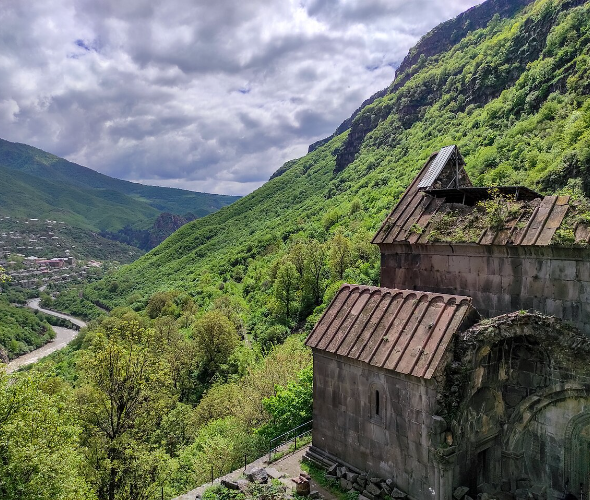Hnevank Monastic Complex
Region
Lori
Distance from Yerevan
142.4 km
Type
Monastery/Church
To the east of the village of Kurtan in Lori lies the Hnevank Monastic Complex, built in the 7th century. At the center of the complex stands the main church, built of yellowish finely hewn felsite. It is a domed, triple-apse structure with a cruciform interior and plain, austere exterior walls. The transition to the dome is supported by two rows of tromps, and the drum is octagonal on the outside. The windows, which illuminate the apses and the drum facades, are bordered with delicate vegetal and geometric ornaments that reflect the skill and taste of medieval craftsmen. The name Hnevank is also mentioned in Georgian sources, related to a donation by King David the Builder of Georgia. In 1123, he granted Lori-Tashir to Ivane Orbelyan, whose son Smbat, in 1154, renovated the main church of Hnevank, as confirmed by a Georgian inscription on the cornice of the dome. During the same period, the complex was expanded: a narthex was added to the west, and to the north of the narthex, a domed single-nave hall was attached. Despite the hardships of time and the weight of history, Hnevank has survived, albeit partly ruined. In the early 13th century, a southern domed church with a semicircular apse was added to the complex. Above the entrance, there are inscriptions detailing its construction. To the north of the narthex, some parts of the single-nave church have been preserved. Around the complex, one can still see the remains of residential and auxiliary buildings, some of which may have served as monastic quarters or an abbot's residence.

Interesting
facts about Hnevank Monastic Complex


Facts
Weather in Lori
The high season in Armenia lasts for a long time due to the pleasant climate conditions. Warm days in Armenia start in March and last until late autumn; winter is usually snowless and not long. The high precipitation season is variable. The tourist season for Hnevank Monastery depends on the weather conditions.












